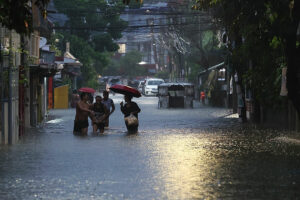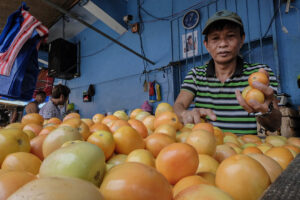POOR FILIPINOS face a higher risk of experiencing floods and dry spells, the Asian Development Bank (ADB) said.
The ADB’s latest Key Indicators for Asia and the Pacific report showed that 16.1 million Filipinos experienced medium-to-high risk of water stress or experienced frequent droughts or intense flooding.
In comparison, 2.2 million people in Thailand experience the same level of water stress.
The report compared the Philippines and Thailand to show how countries with high poverty levels experience varying climate impacts depending on its geographical location. The data were measured using the Philippines’ 16.6% poverty incidence rate in 2018 and Thailand’s 7.8% poverty incidence rate in 2017.
“Poor communities are often disproportionately affected by climate change due to their limited financial resources to adapt or recover,” ADB Statistician Arturo M. Martinez, Jr. said in a virtual briefing on Thursday.
The report showed that all major parts of the Philippines faced medium-to-high risk of water stress.
The entire Metro Manila was exposed to this risk, followed by the rest of Luzon (76%), Mindanao (75%) and the Visayas (71%.) Meanwhile, all regions in Thailand experienced at least 76% of medium-to-high risk of water stress.
Geographic mapping showed that nearly two-thirds of the Philippines’ poor communities, which are spread out around the country, are exposed to medium-to-high risk of water stress
On the other hand, less than a fifth of Thailand’s land area was home to poor communities with high water risk, mostly in the northern region.
The report also showed that 12.7 million poor Filipinos lived in areas with medium-to-high flood risk, covering 59.6% and 51% of total land area susceptible to riverline and coastal flooding, respectively.
This compares to 400,000 poor Thai people in areas facing medium-to-high flood risk, where 33% of the land area is vulnerable to riverline flooding and 3.7% to coastal flooding.
Metro Manila and the Visayas showed 100% vulnerability to coastal and riverline flooding. In Thailand, poor people were susceptible to riverline flooding.
The data were shown using “geographically granular” data, which uses satellite-based maps and computer algorithms to help identify priority climate risk strategies.
“Granular data on vulnerability to climate change may reveal the unique environmental, economic, social, and political challenges faced by diverse places and populations. These data are crucial for targeting regions that require immediate intervention and assistance especially under budget constraints,” Mr. Martinez said.
However, 66% of statistics agencies from the Asia-Pacific reported constraints in the availability, timeliness, and granularity of climate-related data, ADB said.
The ADB noted that poorer countries have a higher level of climate risk. Low-income economies face the highest exposure to climate-related disasters but less coping capacity, while high-income economies are exposed less but have stronger coping strategies.
“Such disparities between income levels and capacity to cope are often mirrored within economies, where impoverished communities typically bear the brunt of climate risks and possess fewer resources to manage them,” according to the report.
The ADB said Asia-Pacific countries are now giving higher priority on environmental protection than economic growth.
“This preference tends to become more prevalent as an economy’s income level rises. In wealthier economies, a larger proportion of respondents favor environmental protection, even if it incurs potential economic costs,” it said.
According to the report, 56.5% of lower middle-income economies in the region said that protecting the environment is a priority even if it causes slower economic growth and some loss of jobs. This is also seen in 59.5% of upper middle-income economies and 61.8% high-income economies.
ADB Chief Economist Albert F. Park said there is a need for more partnerships to make sure vulnerable countries are ready for climate-related disasters.
“To address climate change, we’re going to have a hard time to be effective if we don’t have good data,” he told the webinar.
“I would really emphasize the need to harmonize how we define things because if everyone’s collecting data in a different way, it does become difficult to link our understanding and to learn lessons across countries.”
POOR FLOOD MANAGEMENTThe Philippine government should focus on science-based long-term solutions and risk avoidance strategies like flood forecasting to address the flooding problem, GlobalSource Partners country analysts Diwa C. Guinigundo and Wilhelmina C. Mañalac said in a brief.
In late July, massive floods caused by Typhoon Carina and enhanced southwest monsoon exposed the government’s ineffective flood management strategies over the past decade, they said.
“Careful studies show that the root of the perennial flooding problem is continuity, or specifically, the lack of it,” GlobalSource said.
In 2013, then-Public Works Secretary Rogelio L. Singson proposed a P351-billion flood control masterplan for 11 target areas in the country. However, the plan has not even reached 30% completion a decade since its conception, the Department of Public Works and Highways (DPWH) told senators recently.
“Records show that disbursements for flood control and management projects have decreased even as the budget allocation for these projects has been constantly increasing in the last five years,” GlobalSource said, citing Senate findings.
Citing a Senate press release, GlobalSource said 20% of the DPWH budget between 2020 to 2023 was allocated to flood management. This was increased to 25% in the 2024 budget.
However, the DPWH disbursed only 68.26% of its budget in 2021, 73% in 2022, and 58% in 2023, it said. — B.M.D.Cruz















